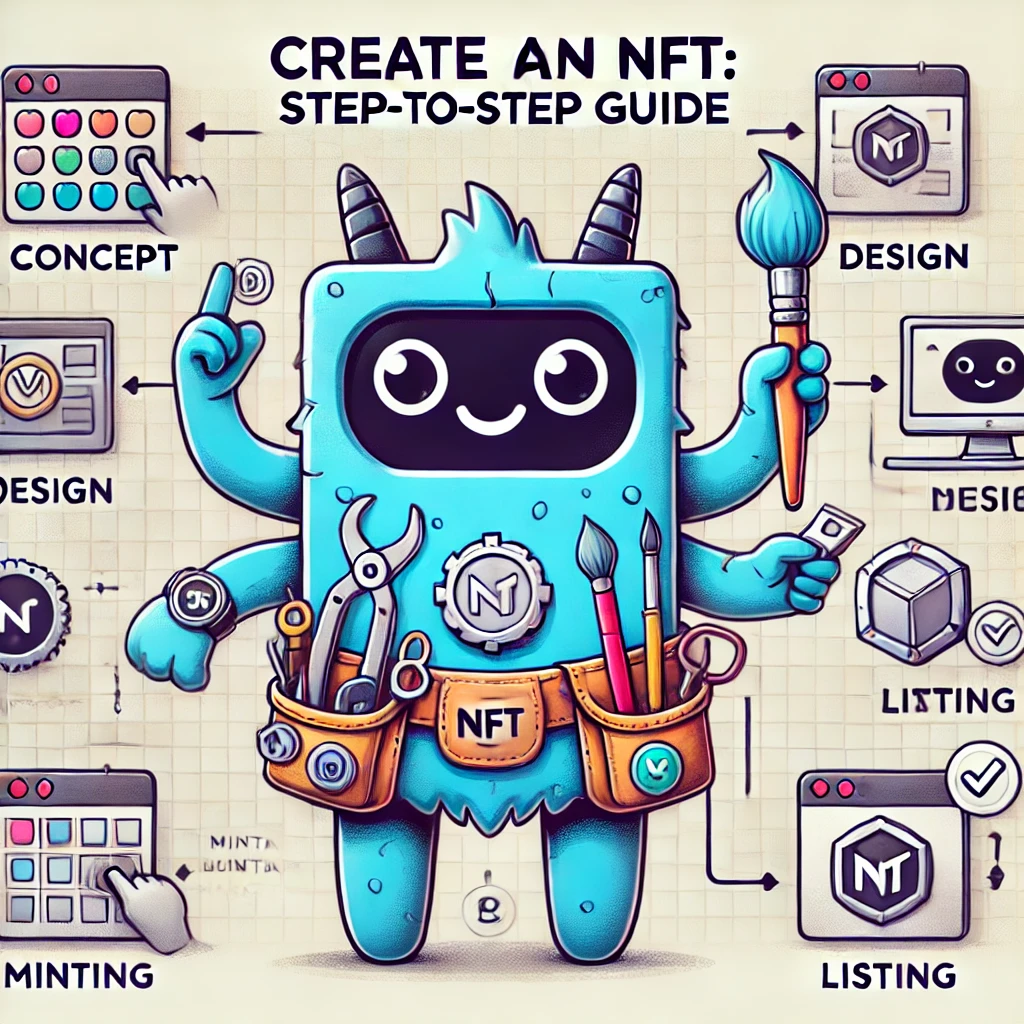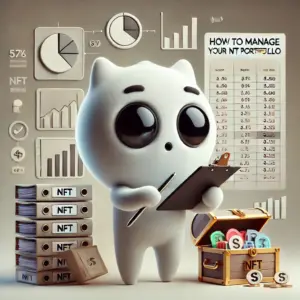In the ever-evolving landscape of digital technology, non-fungible tokens (NFTs) have emerged as a revolutionary force, transforming the way we perceive and interact with digital assets. NFTs, unique digital representations of ownership, have captivated the world with their potential to revolutionize art, gaming, music, and numerous other industries. From collectible digital artwork to virtual real estate, the applications of NFTs seem limitless.
If you’re intrigued by the world of NFTs and are eager to create your own, this comprehensive guide will walk you through the entire process, from conceptualization to deployment. We’ll delve into the intricacies of each step, equipping you with the knowledge and skills necessary to embark on your NFT creation journey.
Table of Contents:
Step 1: Choosing the Right NFT Platform
The first step in creating an NFT is selecting an appropriate platform. Numerous platforms cater to NFT creators, each offering its unique features, benefits, and target audience. The choice of platform can significantly impact the reach, visibility, and overall success of your NFT. Here are some of the most popular and reputable platforms:
Ethereum-Based Platforms
Ethereum, the leading blockchain platform for decentralized applications (dApps), has become synonymous with NFTs. Ethereum-based platforms offer robust infrastructure, extensive developer communities, and a thriving NFT ecosystem.
- OpenSea: As the largest NFT marketplace, OpenSea boasts an extensive collection of NFTs, a user-friendly interface, and a wide range of tools for creators. It’s an ideal platform for both seasoned and novice creators.
- Rarible: Rarible emphasizes community ownership, empowering creators to govern the platform through its native token, RARI. It offers features such as royalty distribution, decentralized governance, and a vibrant creator community.
- Foundation: Known for its focus on high-quality art and curated collections, Foundation attracts artists and collectors seeking a more exclusive and refined NFT experience. It offers a bidding system and a platform for creators to showcase their work.
Other NFT Platforms
While Ethereum dominates the NFT scene, alternative blockchains are emerging, each offering its unique advantages:
- Flow: Developed by Dapper Labs, Flow is designed specifically for NFTs, emphasizing speed, scalability, and user-friendliness. This platform hosts popular NFT projects like NBA Top Shot, which have made Flow a notable player in the NFT space.
- Tezos: Tezos offers a more energy-efficient blockchain with lower fees, making it an attractive alternative to Ethereum. Its focus on sustainability and its vibrant community have made Tezos a compelling option for NFT creators and collectors.
- Polygon (MATIC): As a scalable Layer-2 network built on Ethereum, Polygon offers a more affordable and efficient way to create and trade NFTs. It’s gained popularity for its low transaction costs and fast processing times.
Step 2: Creating Your NFT
The exciting part of the process: transforming your creative vision into an NFT. The specific steps involved may vary depending on the platform you choose, but generally these elements remain consistent:
Conceptualization: Defining Your NFT
Before delving into the technical details, take the time to envision your NFT. Ask yourself crucial questions:
- What type of content will your NFT represent? (Artwork, music, video, virtual item, etc.)
- What value or utility will your NFT offer? (Collectibility, membership, access to exclusive content, etc.)
- Who is your target audience? (Collectors, gamers, music enthusiasts, etc.)
- What story do you want to tell through your NFT?
Preparing Your Content
Once you have a clear concept, you need to prepare the actual content for your NFT. Ensure that the content is:
- High-quality: Whether it’s artwork, a song, or a video, use high-resolution files and professional editing to create a compelling and polished final product.
- In the correct format: Most NFT platforms have specific file formats and size limitations. Consult the platform’s documentation for optimal settings.
- Securely stored: Backup your content in multiple locations to avoid losing your work.
Minting Your NFT
Minting is the process of creating an NFT and registering it on the blockchain. It typically involves these steps:
- Connect Your Wallet: Set up a cryptocurrency wallet compatible with the chosen platform, such as Metamask or Coinbase Wallet.
- Select Your Platform: Log into your chosen NFT platform using your wallet.
- Upload Your Content: Upload the prepared content files and follow the platform’s instructions for creating an NFT.
- Pay Minting Fees: Minting an NFT typically involves paying gas fees to the blockchain network.
- Confirm Your Transaction: Verify the details of your minting transaction and approve it through your wallet.
Step 3: Promoting and Selling Your NFT
Now that your NFT is officially minted, it’s time to get it in front of potential buyers. Effective promotion is crucial for gaining exposure and attracting collectors.
Leverage Social Media
Social platforms offer a powerful way to connect with potential buyers:
- Create Engaging Content: Share high-quality images and videos of your NFT, highlighting its unique features and value.
- Use Relevant Hashtags: Employ relevant hashtags to improve your content’s discoverability.
- Join NFT Communities: Connect with other creators, collectors, and enthusiasts on Discord, Telegram, and other platforms.
- Engage with Followers: Respond to comments and questions, build relationships, and foster a sense of community.
List Your NFT on Marketplaces
List your NFT on reputable marketplaces to reach a wider audience:
- OpenSea: Provides a large and active marketplace with a wide range of buyers and sellers.
- Rarible: Focuses on empowering creators and offers tools for community engagement.
- Foundation: Caters to artists and collectors seeking exclusive and curated NFTs.
Pricing Your NFT
Determining the right price for your NFT is essential. Consider factors like:
- Rarity and Uniqueness: How unique and limited is your NFT?
- Utility and Value: What benefits or access does your NFT provide?
- Market Research: Analyze the pricing of similar NFTs to get a sense of market value.
- Auction or Fixed Price: Decide whether to auction your NFT or set a fixed price.
Marketing and Outreach
Go beyond basic social media promotion:
- Partner with Influencers: Collaborate with relevant influencers or NFT enthusiasts to promote your NFT.
- Community Engagement: Engage with NFT communities and host giveaways or contests to generate interest.
- Press Releases: Share your NFT story with press outlets specializing in blockchain technology and NFTs.
Step 4: Understanding the Legal and Tax Implications
Before you dive headfirst into the world of NFTs, it’s crucial to understand the legal and tax implications involved.
Legal Aspects
The legal landscape surrounding NFTs is constantly evolving. Here are some key considerations:
- Ownership and Intellectual Property: Ensure you have clear ownership rights to the content you’re using. Copyright laws apply to digital content, so ensure you have the necessary permissions or create original work.
- Financial Regulations: Stay informed about regulations regarding the sale and trading of NFTs in your jurisdiction. Taxes on income from NFT sales may apply, and local regulations will influence how you report and manage this income.
Tax Implications
The tax implications of NFTs can be complex:
- NFT Sales as Income: Profits from selling NFTs are generally treated as taxable income in most jurisdictions.
- Capital Gains Tax: If you hold an NFT for a longer period and sell it for a profit, you may be subject to capital gains tax.
- Gas Fees: Gas fees, which are network transaction fees on blockchains like Ethereum, are often deductible as business expenses.
It’s highly recommended to consult with legal and tax professionals to ensure you are compliant with all applicable regulations.
Step 5: Navigating the NFT Landscape: Tips for Success and Avoiding Common Pitfalls
The NFT space is constantly evolving, and staying ahead of the curve is paramount to success. Here are some essential tips for navigating the complexities of this innovative landscape:
Stay Up-to-Date with Industry Trends
The NFT world is dynamic. New technologies, platforms, and trends emerge regularly. Keep abreast of the latest developments by:
- Following NFT News and Blogs: Subscribe to industry-leading publications and blogs to stay informed about market trends, emerging platforms, and regulatory changes.
- Engaging in NFT Communities: Participate in online communities and forums where creators and enthusiasts share insights, tips, and news.
- Attending NFT Events and Conferences: Network with industry experts and learn about the latest advancements at conferences and events.
Build Strong Community Relationships
Cultivating a strong community around your NFT is essential for its success:
- Promote Engagement: Encourage interaction with your followers on social media and through other channels to foster a sense of belonging.
- Create Exclusive Content: Offer exclusive benefits and content to holders of your NFT to build loyalty and create a sense of community.
- Collaborate with Other Creators: Join forces with other NFT creators to cross-promote and expand your network.
Protect Yourself from Scams and Fraud
The NFT landscape, while promising, is also teeming with scams and fraudulent activities. Here are some crucial steps to protect yourself:
- Verify Accounts and Links: Be cautious of fake accounts or misleading links and always verify the legitimacy of the platform or individuals you’re interacting with.
- Use Strong Security Measures: Employ robust passwords, two-factor authentication, and security software for your cryptocurrency wallets and online accounts.
- Beware of Pump-and-Dump Schemes: Recognize that some projects may be artificially inflated to lure in buyers, leading to sharp price drops later.
Conclusion: The Future of NFTs and Your Role in It
The world of NFTs has come a long way, and its potential to reshape the digital landscape continues to grow. From revolutionizing digital art to forging new avenues of creativity and ownership, NFTs are empowering individuals and fostering innovation across various sectors.
By understanding the principles and processes involved in creating and promoting NFTs, you can tap into this transformative technology and unleash your own creative potential. Remember to stay informed, embrace the innovative spirit, and navigate the ever-evolving NFT landscape with a keen eye for opportunity. Your journey in the NFT realm holds the promise of exciting discoveries, collaborative ventures, and the creation of valuable digital assets that can leave a lasting impact.
FAQs:
Here’s a look at some of the most frequently asked questions about NFTs:
What are NFTs?
Non-fungible tokens (NFTs) are unique digital assets that represent ownership of a specific item, whether it’s an artwork, a collectible, or a virtual item. NFTs are stored and secured on a blockchain, ensuring their authenticity and immutability.
Why are NFTs so popular?
NFTs have gained immense popularity due to their unique features, including:
- Scarcity: Their digital scarcity makes them attractive to collectors and investors.
- Authenticity: The blockchain guarantees the authenticity of NFTs, preventing counterfeiting.
- Programmable Properties: NFTs can incorporate features and functionalities, such as royalties for creators, access to exclusive content, or membership benefits.
Who can create NFTs?
Anyone can create an NFT, from artists and musicians to developers and game designers. The NFT realm is open to individuals and businesses looking to monetize their digital creations or offer unique ownership experiences.
How much does it cost to make an NFT?
The cost of creating an NFT varies significantly depending on factors such as the platform used, gas fees, and marketing expenses. You can create basic NFTs for relatively low costs, while more complex or high-demand NFTs may involve higher expenses.
What are some of the risks involved in NFTs?
NFT investments can be risky:
- Volatility: The NFT market can be highly volatile, leading to price fluctuations.
- Scams and Fraud: The NFT ecosystem is prone to scams and fraudulent activities.
- Legal and Tax Implications: Navigating the legal and tax complexities associated with NFTs can be challenging.
Before investing in NFTs, conduct thorough research, understand the risks, and consult with financial professionals.
Is creating and selling NFTs a good way to make money?
While NFTs offer opportunities to generate income, there’s no guarantee of financial success. The NFT market is competitive, and success depends on factors like the quality and uniqueness of your NFT, marketing effectiveness, and overall market demand.
What are the future possibilities of NFTs?
The future of NFTs holds immense potential. Experts predict that NFTs will continue to revolutionize various industries, including:
- Gaming: NFTs can create in-game assets, virtual worlds, and unique gaming experiences.
- Music: NFTs can enable musicians to mint and sell their music directly to fans, bypassing traditional intermediaries.
- Real Estate: NFTs can represent ownership of virtual real estate in metaverse platforms.
- Supply Chain Management: NFTs can track and verify the authenticity and provenance of products throughout the supply chain.
The possibilities are limitless. As technology continues to evolve, NFTs are poised to reshape the world as we know it.






